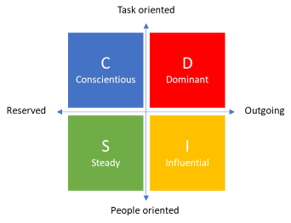If you are new to the idea of Team Praxis, please read our introduction to the concept before using the table below to improve your communications with team members, stakeholders and anyone else involved in your project, programme or portfolio.

The goals of business case management are to:
- summarise context and delivery in a single document;
- explain the desirability, achievability and viability of the proposed work;
- develop the primary document that will be used to support a ‘go/no go’ decision at all gates in the life cycle;
- update and maintain the business case throughout the life cycle.
When implementing these goals people with different character traits would perceive the business case and its management in different ways.
 Concientious behaviour would typically propose or want to see: Concientious behaviour would typically propose or want to see:
-
an objective and detailed description of the context and means of delivery, captured in a single, version-controlled document, issued formally to the core team; -
a factual explanation of the desirability, achievability and viability of the work using tangible and validated information; -
reference back to the metrics within the business case at all gates through the lifecycle to check on their validity; -
regular and comprehensive review of the business case document and close configuration management and change control; -
distribution of business case revisions to appropriate individuals to ensure there is a consistent understanding. Someone exhibiting concientious behaviour would typically be perceived as: -
formal and objective; -
sticking to the agreed business case processes; -
wishing to see good quality and validated information being used; -
cautious and requiring time to make considered decisions if changes are required; -
favouring an iterative approach to the creation of the business case to enhance the accuracy. |  Dominant behaviour would typically propose or want to see: Dominant behaviour would typically propose or want to see:
-
a high-level summary of the context and delivery providing only core information to key decision makers; -
a focused explanation of the desirability, achievability and viability of the proposed work clearly articulating what will be achieved and accountabilities; -
reference to the key elements of the business case at major gates through the life cycle; -
decisions made quickly if there are changes to the business case; - updating of the business case only when necessary and only on those areas which are impacted.
Someone exhibiting dominant behaviour would typically be perceived as: -
direct and to the point; -
working broadly to the business case process until they believe it hinders progress; -
dismissive of activities and content that they perceive as unnecessary and bureaucratic; -
decisive when choices need to be made about the business case even when there is uncertainty. |
 Steady behaviour would typically propose or want to see: Steady behaviour would typically propose or want to see:
-
a comprehensive description of the context and means of delivery that can be used to ensure the team and stakeholders have a common understanding, likely through one-to-one briefings; -
a positive explanation of the desirability, achievability and viability of the proposed work written to appeal to stakeholders and focusing on the advantages to people; -
reference to the specifics within the business case and discussion with key stakeholders at all gates through the life cycle; -
regular updating of the business case capturing changes agreed with key stakeholders and re-briefing of the team as required. Someone exhibiting steady behaviour would typically be perceived as: -
informal and approachable if issues need to be discussed; -
empathetic to the impact of the delivery of the business case on people; -
cautious as they work through the agreed business case process and wishing to minimise risk; -
indecisive in particular when there is uncertainty or time pressures. |  Influential behaviour would typically propose or want to see: Influential behaviour would typically propose or want to see:
-
an informative high-level summary of context and delivery ensuring the team and stakeholders have a common understanding through group briefings; -
a compelling and engaging explanation of the desirability, achievability and viability of the proposed work highlighting opportunities; -
a broad discussion about the business case at key gates with the core team, including identification of new opportunities that may have arisen; -
updates to the business case after discussion with key stakeholders and re-briefing of the team as required. Someone exhibiting influential behaviour would typically be perceived as: -
relatively relaxed regarding the need for a business case; -
innovative and wishing to see people involved in identifying options; -
informal and often working around the processes where they are seen as constraining; -
fast paced and wishing to see decisions taken quickly without being overly burdened by process; -
happy to express information and make business case decisions based on gut feel and later backing up with data. |
Thanks to Donnie MacNicol of Team Animation for providing this page.


 Concientious behaviour would typically propose or want to see:
Concientious behaviour would typically propose or want to see: Dominant behaviour would typically propose or want to see:
Dominant behaviour would typically propose or want to see: Steady behaviour would typically propose or want to see:
Steady behaviour would typically propose or want to see: Influential behaviour would typically propose or want to see:
Influential behaviour would typically propose or want to see:



